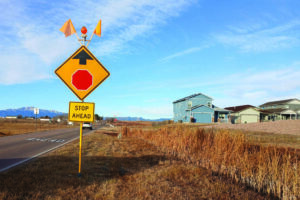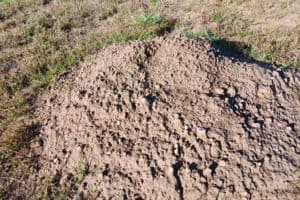Longtime local journalist Bill Radford and his wife, Margaret, live on 5 acres in the Falcon area with ducks, chickens, rabbits, dogs, cats, two noisy parrots, goats and two horses. Contact Bill at billradford3@gmail.com.
Weather forecasters had warned for days that this could be the big one. Snow predictions varied, but all agreed that the wind would be horrendous.And it was. The bomb cyclone that rampaged through the area on March 13 unleashed winds of nearly 100 miles per hour and produced whiteout conditions for most of the day.It started with rain overnight. The rain was still falling that morning when I raced to the Falcon Walmart for a couple of supplies. My wife, meanwhile, had gone to the Springs for a key breakfast meeting but promised to be back before the snow began; a blizzard warning was in effect beginning at 10 a.m.Sure enough, the rain changed to snow around 10. It was warm enough that, at first, surfaces other than the ground just stayed wet. But at 10:27 a.m., I texted Margaret, who still was not home, to warn her: “Icing up.”Visibility was becoming nil; I could no longer see the barn. At 11:10, Margaret texted to say she was safe. ìBut I am in what I think is probably a traffic jam on Woodmen coming into Falcon, and I think we’re all stuck here.”That began an 11-hour ordeal for Margaret, who would later acknowledge that she never should have ventured out to begin with. She would not be the only one with regrets; at one point, a reported 1,100 vehicles were stuck on the roadways. The path was cleared for Margaret and other motorists on Woodmen to move forward at around 8 p.m. Margaret only made it 100 yards or so, though, before driving into a ditch in the still-whiteout conditions; it took another hour and a half before she was finally safe and warm.At home, it wasn’t long before pretty much every window and door was plastered with snow and ice, making it difficult if not impossible to check conditions outside. The back sliding-glass doors, which faced the west, had some clear spots, so I could peek out through them ó though there was nothing to see most of the time except a wind-swept wall of white. The most alarming part was when those sliding-glass doors would bow in and out, making me worried that they might not remain.The electricity blinked in and out many times; with one of those times, the furnace failed to come back on. The pilot light had blown out; and, as I would later find out, the furnace cap on the roof had become encased in ice; it wasn’t until late the next afternoon, once that ice had melted, that I could get the furnace running again. We have a wood-burning stove, but I was reluctant to start a fire with hurricane-force winds howling. I did use a space heater to keep the living room ñ- and the dogs -ñ warm enough.The power, despite the repeated brief interruptions, stayed on. Others weren’t so lucky. At the height of the storm, more than 24,000 of Mountain View Electric Association’s nearly 48,000 members lost power over MVEA’s 5,000-square-mile service territory. By Saturday evening, three days after the storm, power had been restored to all, said Sarah Schaefer, MVEA public information officer. “This was a very historic storm,” she said via email. (It also, tragically, was a deadly storm, claiming at least two lives.)As the afternoon wore on, there were brief periods when I could see the barn. At around 5, I headed outside to check on and feed the horses. It was difficult to stand in the wind, though, and when I ended up in a snowdrift up to my knees and couldn’t move forward, I abandoned the effort.An hour later, I tried again. This time, I crawled over the drift, commando style, rather than trying to push my way through. I made it to the barn and found hungry horses and goats ó and a lot of snow that had whipped into the barn. I did not try to reach the ducks, chickens and rabbits, all in enclosures on the south side of the property; I simply hoped they were all hunkered down and safe. Once I finally knew Margaret was rescued, after 10 p.m., I went to bed, grateful that the power was still on and that we had bought ourselves electric blankets for Christmas. (Margaret wouldn’t actually make it home until the next evening.)I was up before dawn the next morning. The skies had cleared and the winds had eased, and as sunlight began to splinter the eastern sky, I could begin to survey the situation.People always ask after a storm: How much snow did you get? And with the wind-swept storms, I can never answer that question. Our pasture had snow, but not much more than a dusting. But the snowdrifts were incredible; it’s the first time we’ve had drifts well over my head. And the winds had apparently come from a somewhat different direction than usual, or perhaps had swirled in all directions, because we had drifts in unusual places; much of the chicken coop, for example, was buried in snow. (The chickens were fine; their entrance was still usable, but they didn’t seem to be in any hurry to venture out.)Our neighborhood tractor guy, Loy, came to the rescue, cleaning a path from the road to our garage as well as a path to the barn. I spent the day digging out elsewhere, most notably the front entrance to the house, which was barely visible, and a path to the chickens and ducks. More digging would follow over the next couple of days; we also had to install a temporary fence over part of the permanent fence in the goat yard once the goats figured out they could walk up a drift and simply stroll over the now-buried fence.Damage, overall, was minimal: We lost the door to our tack shed and a couple of trees had their branches ripped off by the weight of the snow. But if that is the last and only bomb cyclone I experience, that will be fine with me.





